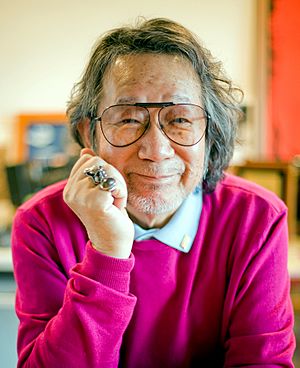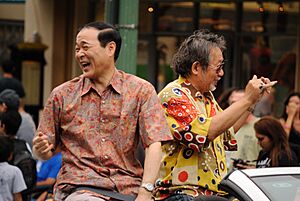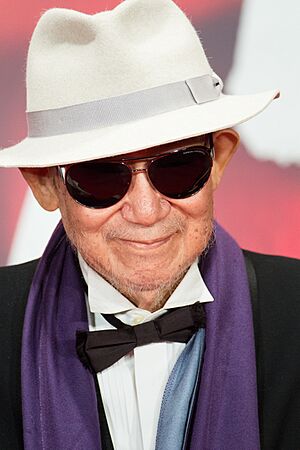Nobuhiko Obayashi facts for kids
Quick facts for kids
Nobuhiko Obayashi
|
|
|---|---|

Obayashi in 2019
|
|
| Born | 9 January 1938 Onomichi, Japan
|
| Died | 10 April 2020 (aged 82) Tokyo, Japan
|
| Occupation | Film director, screenwriter, editor, film producer |
| Years active | 1960–2020 |
| Spouse(s) | Kyoko Obayashi |
| Children | Chigumi |
Nobuhiko Obayashi (大林 宣彦, Ōbayashi Nobuhiko, 9 January 1938 – 10 April 2020) was a famous Japanese film director. He also wrote screenplays and edited films. He was known for making both movies and TV commercials.
Obayashi started his career making experimental films. These were creative and unusual movies. Later, he moved on to direct more popular films. His career as a director lasted almost 60 years.
He is most famous for directing the 1977 horror film House. This movie became a "cult classic," meaning it has a strong, dedicated fanbase. Obayashi was known for his unique, dream-like filmmaking style. Many of his films also shared important anti-war messages.
Contents
Early Life and First Films
Nobuhiko Obayashi was born on January 9, 1938, in Onomichi, Japan. His father was a doctor who went to fight in World War II. Because of this, his grandparents raised him when he was very young.
As a child, Obayashi loved many artistic things. He enjoyed drawing, writing, and playing the piano. He was also very interested in animation and movies. He made his first film when he was just six years old in 1944. It was a hand-drawn animated short film called Popeye's Treasure Island.
Starting a Film Career
In 1955, Obayashi's father wanted him to become a doctor. However, Nobuhiko decided to follow his artistic dreams instead. He went to Seijo University in 1956 to study liberal arts. There, he began working with 8 mm and 16 mm film.
While at university, he started making short experimental films. These films were very creative and pushed the boundaries of filmmaking. Obayashi, along with other filmmakers, formed a group called Film Independent. Their work helped shape Japanese experimental cinema in the 1960s. Obayashi used many unique techniques in these early films. He later brought these ideas into his more popular movies.
From Commercials to Cult Classics
After university, Obayashi kept making experimental films. A company called Dentsu, which made TV commercials, asked him to direct ads. Obayashi was the only one from his group to say yes. This is how he started earning a living as a director.
His TV commercials had a cool, artistic look, much like his experimental films. In the 1970s, he directed many Japanese ads. These often featured famous American stars like Kirk Douglas and Charles Bronson. Throughout his career, Obayashi directed about 3,000 television commercials!
He made his first full-length movie, House, in 1977. This horror film used special effects and unusual camera tricks. It created a very unique and dream-like visual style. House quickly became a "cult classic" and is still loved by many fans today. The film also won Obayashi the Blue Ribbon Award for Best New Director.
Mainstream Success and Anti-War Films
Throughout the 1980s and beyond, Obayashi continued to make popular feature films. He directed several "coming-of-age" movies. These films tell stories about young people growing up. Some of these include I Are You, You Am Me (1982), The Girl Who Leapt Through Time (1983), and Lonely Heart (1985). These three films are known as his "Onomichi trilogy," named after his hometown.
His 1988 film The Discarnates was shown at the Moscow International Film Festival. In 1998, his film Sada won an award at the Berlin International Film Festival. It was praised for its new style and understanding of people.
In 2016, Obayashi was diagnosed with a serious illness. Doctors thought he only had a few months to live. But he didn't stop working! He started making Hanagatami, a film he had wanted to make for over 40 years. This movie came out in 2017 and won many awards. Hanagatami is part of a group of modern anti-war films by Obayashi. The others are Casting Blossoms to the Sky (2012) and Seven Weeks (2014).
He even filmed and edited his last movie, Labyrinth of Cinema, while getting treatment for his illness. This final film premiered at the Tokyo International Film Festival in 2019.
Death
Nobuhiko Obayashi passed away on April 10, 2020, in Tokyo. He was 82 years old and died from lung cancer. His family held a funeral for him a few days later.
Honors
- Medal with Purple Ribbon (2004)
- Order of the Rising Sun, 4th Class, Gold Rays with Rosette (2009)
- Person of Cultural Merit (2019)
Images for kids
See also
 In Spanish: Nobuhiko Obayashi para niños
In Spanish: Nobuhiko Obayashi para niños





